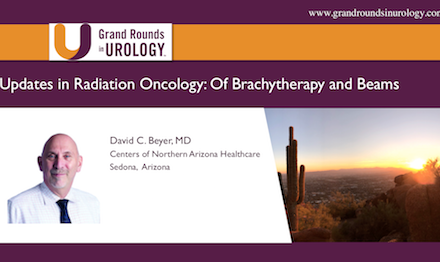Peter F. Orio, DO, MS, presented “Role of Prostate Brachytherapy in Gleason 8-10 Disease” as part of a course on Prostate Brachytherapy released in 2021 and created by the American Brachytherapy Society in partnership with Grand Rounds in Urology.
How to cite: Orio, Peter F. “Role of Prostate Brachytherapy in Gleason 8-10 Disease.” September 2021. Accessed Oct 2024. https://grandroundsinurology.com/role-of-prostate-brachytherapy-in-gleason-8-10-disease/
Role of Prostate Brachytherapy in Gleason 8-10 Disease
As part of a special course on brachytherapy for prostate cancer from the American Brachytherapy Society (ABS) and Grand Rounds in Urology, Peter F. Orio III, DO, MS, Vice Chair of Network Operations for Dana-Farber/Brigham and Women’s Cancer Center Department of Radiation Oncology and Associate Professor of Radiation Oncology at Harvard Medical School in Boston, Massachusetts, discusses brachytherapy’s role in treating high-risk prostate cancer (PCa). He shares the largest prostatectomy series to report cause-specific survival (CSS) by biopsy Gleason score (and the largest prostatectomy series to report CSS in the prostate-specific antigen [PSA] era), highlighting data that demonstrate that men with T3 disease have a 38 percent chance of prostate-cancer-specific mortality (PCSM) and men with a Gleason score of 8-10 have a 34 percent chance of PCSM. Further, long-term surgical biochemical progression-free survival (bPFS) among men with a Gleason score of 8-10 is on the order of 30-40 percent. Dr. Orio then displays data from a comparative analysis of PSA-free survival outcomes for patients with high-risk PCa by radical therapy. It shows that external-beam radiation therapy (EBRT) with brachytherapy (with or without androgen-deprivation therapy [ADT]) has better PSA-free progression than do other radical therapies. He cites data that show when brachytherapy is added to EBRT, patient outcomes improve. He then introduces three clinical trials examining EBRT with and without brachytherapy to examine more closely. In the first trial, at a median follow-up of 8.2 years, patients treated with EBRT with a brachytherapy component had half the biochemical failure compared with patients treated with EBRT alone. Similarly, another randomized trial of EBRT alone or combined with high-dose brachytherapy boost showed similar improved outcomes, with better biochemical relapse-free survival at five, seven, and 10 years for patients who underwent the combined therapy. Dr. Orio then turns to the ASCENDE-RT Trial, which compared a low-dose-rate prostate brachytherapy (LDR-PB) to a dose-escalated EBRT (DE-EBRT) for patients with high- and intermediate-risk PCa. Data showed a benefit to the LDR-PB, with an absolute difference in the proportion of patients free of recurrence of nearly 21 percent at nine years. Similar results occurred among intermediate-risk patients and high-risk patients. Dr. Orio goes on to compare the progression-free survival at seven years among high risk patients who received the LDR-PB (83 percent) with the surgical bPFS of 30-40 percent, concluding that brachytherapy can spare many men the need for salvage therapies. He then addresses toxicity concerns about the LDR-PB, explaining that practitioners should avoid the dragging of seeds to the membranous urethra, where they have the potential to cause a urethral stricture. Dr. Orio explains that doctors can decrease toxicity by identifying the apex of the prostate, making it easier to control placement of the seeds and avoid toxicity. He goes on to explain other solutions to reduce toxicity such as using a gel spacer between the prostate and the rectum. Dr. Orio cites one additional study confirming that EBRT with brachytherapy leads to better patient outcomes compared with radical prostatectomy or EBRT alone. Dr. Orio advises that patients with intermediate- or high-risk PCa receiving EBRT +/- ADT should be offered brachytherapy as a dose escalation strategy because it is proven with Level 1 evidence. He explains that the American Society of Clinical Oncology (ASCO) stated that eligible intermediate- and high-risk PCa patients choosing EBRT with or without ADT should be offered brachytherapy. Dr. Orio states that a rising PSA condemns many men to expensive, toxic, and quality-of-life-reducing treatments and asks if society is prepared for this cost to normalize overall survival. He asserts that we should instead consider using brachytherapy in those with higher-risk disease.
For more on brachytherapy, check out the first module of the free Prostate Brachytherapy course from GRU and the American Brachytherapy Society.
ABOUT THE AUTHOR
Peter F. Orio III, DO, MS, is Vice Chair of Network Operations for the Dana Farber Brigham Cancer Centers in Boston, Massachusetts. He also serves as the Director of Prostate Brachytherapy for the Dana Farber Brigham Cancer Centers and is an Associate Professor at Harvard Medical School. Dr. Orio earned his Bachelor of Arts in Biology/Psychology from the College of the Holy Cross, his Master’s of Science in Public Health from the University of Massachusetts at Amherst and his Doctor of Osteopathic Medicine degree from the University of New England College of Osteopathic Medicine. He completed his residency in radiation oncology at the University of Washington Medical Center. Dr. Orio served in the US Army as Assistant Chief of Radiation Oncology at Brooke Army Medical Center, where he rose to the rank of Lieutenant Colonel. Dr. Orio is active in the American Brachytherapy Society (ABS) and the American Society for Radiation Oncology (ASTRO), focusing his efforts on the advancement of brachytherapy for prostate cancer and the socioeconomics of medicine.




